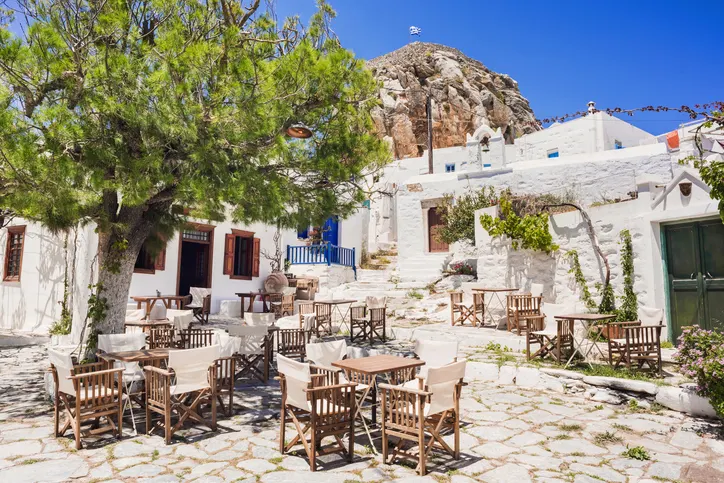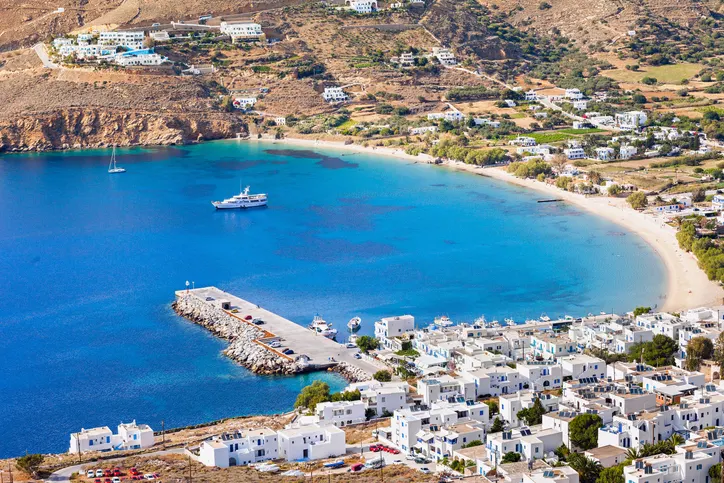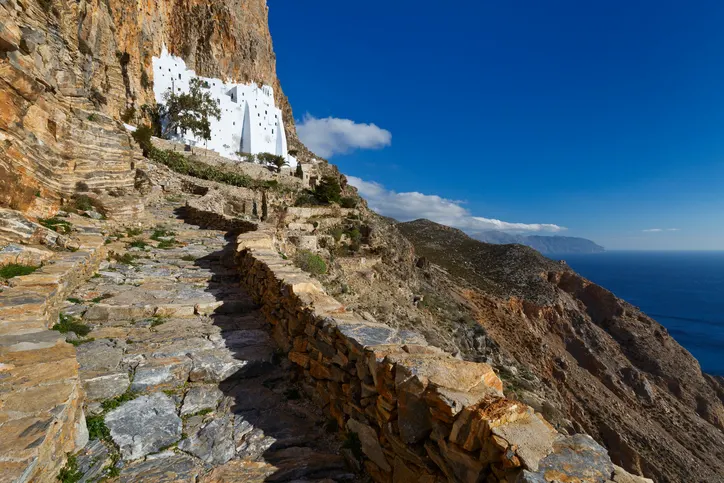If "off-the-beaten-track” is your vibe, Amorgos might be the island for you.
The most eastern island of the Cyclades group, Amorgos is a mountainous, rugged island with a land mass of 49 square miles (126 square kilometers) and a year-round population of under 2,000 residents.
Get Your Free Greece Report Today!
Get Your Free Greece Report Today!
Learn more about a slower pace of life in Greece and other countries in our free daily postcard e-letter. Simply enter your email address below and we'll also send you a FREE REPORT — Retire in Greece—Find Your Dream Retirement in This European Archipelago.

By submitting your email address, you will receive a free subscription to IL Postcards, Overseas Dream Home, The Untourist Daily and special offers from International Living and our affiliates. You can unsubscribe at any time, and we encourage you to read more about our Privacy Policy.
There are many theories about where the island got its name. Some say it is named after the plant “amorgis,” which grew wild on the island in ancient Greece and was used to make tunics. Others point to the word “mourga,” a dark-colored oil sentiment, and suggest this was used to describe the color of the sea as waters surrounding the island, as Amorgos has water as deep as 840 feet/256 meters at some points of the island. The island has a rich history and has been ruled by Romans, Venetians, Ottomans, and Greeks. This web of influences is seen in the ancient ruins and architecture of the island.
The island is known for its multitude of “Blue Path” hiking routes and walking trails, aptly named because these trails offer stunning views of the blue Aegean Sea. The island has so much natural beauty that it served as the film location for the 1998 movie The Big Blue and the 2022 movie Two Tickets to Greece.
Getting There

In keeping with its off-the-beaten-path reputation, Amorgos is accessible only by ferry, so you can sail from Athens on the mainland or from other islands in the Aegean.
For those taking the ferry directly from Athens, you can sail from the port of Piraeus to Katapola, the main port of Amorgos, or Aegiali, a secondary port located on the island's northeastern side. There are a variety of boat options ranging from travel times of just under six hours to nearly eight and a half hours.
There is no airport on the island. The closest airport is on the island of Naxos, so some people fly to Naxos and take the ferry from there. The ferry from Naxos to Amorgos takes one hour and twenty minutes to four and a half hours.
You can also choose to fly to Santorini and take one of the daily ferries to Amorgos’s Katapola port. This ferry ride is a brisk one hour and fifteen minutes.
Getting Around

Renting a car is the easiest and most effective way to see Amorgos. Having your own car gives you the freedom to explore the island at your own pace and means you can access some of the more secluded areas. You’ll have plenty of rental car options in the port cities of Katapola and Aegiali.
For those seeking an adventure, water taxis from Katapola can bring you to the more remote beaches of Maltezi and Plakes. You can also take a water taxi from Agios Pavlos to the beaches of Nikouria, a small uninhabited islet with three sandy beaches.
If you want to avoid the stress of driving, you can take the KTEL public buses, which run from early to late at night. The Amorgos Bus Company gives the timetables of public buses and offers private bus options.
Taxis are also an option, and while they are more expensive than buses, they are more comfortable and efficient in getting you to your destination. As taxis are limited on the island, be sure to book in advance.
When to Go

Amorgos is one of the few Greek islands where you don’t need to worry too much about overcrowding. Summer months are traditionally the most popular time to visit, and the beaches are at their best during June-September. The high season is the months of July and August, and during this period, expect hot days and temperate nights.
If you are coming for hiking or to enjoy natural beauty, you can visit the island year-round, although it will be colder and more desolate in the winter months.
Here are a few notable dates to consider while planning your trip:
May’s Trail Run Challenge: In early May, runners come from all over the world to participate in a weekend of trail running through the paths of Amorgos. The Spike race is my favorite, offering an exciting trail that starts at sea level with runners heading for the peak of Nikouria island, a nearby uninhabited island that runners reach by a traditional fishing boat. Runners receive a special stamp at the top of the peak before beginning their descent to the finish line on the beach. It’s a once-in-a-lifetime experience. The 2024 Trail Run Challenge was a huge success, so check the dates for the year of your visit.
Greek Orthodox Easter is a wonderful time to visit Amorgos and experience Greece’s biggest holiday in a traditional setting. The Orthodox Easter date changes each year, so check your calendar. However, the whole week leading up to Easter Sunday (called the Big Week or Megali Evdomada) is an exciting time to see the island and immerse yourself in Greek culture.
On July 25th and 26th, the festival of Agia Paraskevi is celebrated in Kato Meria in Amorgos, gathering thousands of people every year. It is one of the biggest festivals in the Cyclades, beginning with an evening service on July 25th and stretching into a colorful feast on July 26th. The feast features dancing, local music, and traditional food, including the famous “patatato” dish made with lamb and goat meat.
If a panegyri (Saint’s Day festival) is what you seek, head to Amorgos on August 6th for the festival of Christos, which takes place in the capital town of Chora every year. Organized by the Simonides Cultural Association, this festival features long rows of communal tables, delicious food, and dancing until the early hours.
August 15 (called Dekapent Avgoustos) is the Feast Day of Mary and the second biggest holiday in Greece. Most islands are packed on this date, but because of the “under the radar” status of Amorgos, it is a great island choice for this holiday celebration.
Get Your Free Greece Report Today!
Get Your Free Greece Report Today!
Learn more about a slower pace of life in Greece and other countries in our free daily postcard e-letter. Simply enter your email address below and we'll also send you a FREE REPORT — Retire in Greece—Find Your Dream Retirement in This European Archipelago.

By submitting your email address, you will receive a free subscription to IL Postcards, Overseas Dream Home, The Untourist Daily and special offers from International Living and our affiliates. You can unsubscribe at any time, and we encourage you to read more about our Privacy Policy.
Where to Stay

Set on a hill above the port town Katapola, The Big Blue Pension offers stunning views of the village and the sea. Aegean of Amorgos is a fresh, clean, modern hotel just 200 meters from the port, offering pet-friendly accommodations.
Near the Aegiali port, Anatoli Rooms, with direct access to the beach, is a popular choice. Try the seaside gem Petradi Studios, consisting of three studios, one villa, and a delightful beach bar. At Petradi Studios, be sure to ask for my friend Elli, who manages the bar and hotel when she isn’t offering pilates or fitness classes!
In Chora, the capital village in the center of the island, check out the Politimi Studios, which offers seven smartly furnished apartments in the center of town.
What to Do

1. Put on Your Hiking Shoes and Explore the Blue Paths
Amorgos is known for its hiking and the seven “Blue Paths” offer visitors well-marked trails for all levels.
Start with the Fotodotis hike, a one-hour, easy walking path from Chora, the island’s capital village, to Katapola, the main port in the center of the island. Along the way, you’ll pass the chapel of the Madonna of Fidopotamianis and immediately after the chapel of the Archangel. The path continues through the fields and olive groves of Milies and ends in Katapola.
For something slightly more ambitious, take the Valsamitis Path, a circular route from the port village of Katapola to St. Georgios Valsamitis and back to Katapola. Because of its hilltop location, St. Georgios Valsamitis offers sweeping views of the valley below and the sea. The church itself is peaceful and soothing, with beautiful icons and a tall bell tower. Look for the old watermill next to the church. On the return hike, you will pass through the ancient site of Minoa, at Moundoulia Hill, above the port of Katapola. This was originally the summer residence of the Cretan King Minos.
The Old Strata Path is a popular option for experienced hikers, taking four to five hours and extending from Chora (the island capital) to Langada, a village in the north surrounded by the highest mountains on the island. Be sure to take lots of water for this difficult level hike. This hike features the island’s most popular attraction, the Monastery of Panagia Hozoviotissa (see below).
See the full list of the seven Blue Paths.
2. Sip Raki with the Monks at the Monastery of Panagia Hozoviotissa
One of the top attractions in Amorgos is the Monastery of Panagia Hozoviotissa, which has earned this reputation because of its dramatic location. Hanging on the edge of a cliff, the site offers a remarkable blend of spiritual significance, raw beauty, and classic Greek hospitality.
Expect to be greeted by signs reminding you of the dress code (men wear long pants and women wear long skirts) and friendly monks offering you raki, the traditional Greek liquor, along with loukoumi, a sugary Greek sweet, as a welcome.
The monastery was built in 812-813 AD and renovated in 1088 AD by Byzantine Emperor Alexios A. Komninos. It was erected as a tribute to the Virgin Mary, who is also the protector of the island. The chapel inside the monastery is home to many religious treasures. The monastery's windows frame stunning views of the Aegean Sea and the surrounding raw natural beauty. Bring your camera and get ready for breathtaking scenes.
3. Explore the Sea Life Along the Coast
From sea caves to shipwrecks, Amorgos offers some beautiful and unique marine opportunities.
The Olympia shipwreck, located near Kalotaritissa Beach, was made famous when it became part of the set for the "The Big Blue '' movie. The boat sank in 1980, and its dramatic form has become one of the most iconic images of Amorgos.
Check out the sea caves at Mouros Beach on the southeast side of the island. Mouros Beach itself is a small, pebble beach with rock formations around the shore. Behind the rocks are two small caves that offer swimming and snorkeling opportunities.
Agia Anna’s beach, located near the Hozoviotissa Monastery, was also made famous when it was used as a filming location for the film “The Big Blue.” This small, rocky beach is beautiful and raw–be sure to bring your own umbrellas and supplies.
As you can see, Amorgos is an island for nature lovers and anyone seeking a truly authentic Greek experience, so put on your hiking boots and book your ferry ticket!
Get Your Free Greece Report Today!
Get Your Free Greece Report Today!
Learn more about a slower pace of life in Greece and other countries in our free daily postcard e-letter. Simply enter your email address below and we'll also send you a FREE REPORT — Retire in Greece—Find Your Dream Retirement in This European Archipelago.

By submitting your email address, you will receive a free subscription to IL Postcards, Overseas Dream Home, The Untourist Daily and special offers from International Living and our affiliates. You can unsubscribe at any time, and we encourage you to read more about our Privacy Policy.
